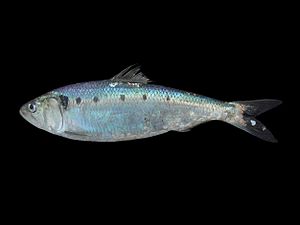Twait shad facts for kids
Quick facts for kids Twait shad |
|
|---|---|
 |
|
| Conservation status | |
| Scientific classification | |
| Genus: |
Alosa
|
| Species: |
fallax
|
The twait shad (Alosa fallax) is a type of fish that lives in the ocean. It belongs to the Alosidae family. You can find it in the eastern Atlantic Ocean and the Mediterranean Sea. This fish is special because it is an anadromous fish. This means it lives in the sea but travels into fresh water to lay its eggs.
The twait shad looks a bit like an Atlantic herring. However, it has a clear row of six to ten dark spots on its shiny, silver sides. These fish grow up and become ready to have babies when they are three years old or more. They travel to river mouths, called estuaries, and then swim up rivers to lay their eggs. Sadly, the number of twait shad has gone down. This is because of too much fishing, dirty water, and places where they live being destroyed. There are rules and agreements, like the Bern Convention, to help protect this fish.
Contents
About the Twait Shad
The twait shad is a typical fish from the herring family. It looks a lot like the allis shad. This fish does not have a lateral line, which is a special sensing organ. Its belly is more rounded than other fish like the sprat or Baltic herring.
The cover over its gills has ridges. The part of its body just before the tail, called the caudal peduncle, has large, flat scales. The twait shad is more colorful than the Baltic herring. Its back is a bluish-green color. Its head is brownish, and the gill cover has a golden shine. Its sides are silver, sometimes with a bronze color. There is a clear row of six to ten big dark spots right behind the gill cover. These spots might fade away after the fish dies. An adult twait shad is usually about 25 to 40 centimeters long.
Where Twait Shad Live
The twait shad can be found in most parts of Europe. It also lives in all the countries that are next to the Mediterranean Sea.
Twait Shad Life Cycle
The twait shad (Alosa fallax) has a life cycle similar to the allis shad (A. alosa). These two types of fish are sometimes found living in the same areas. Some studies even suggest that A. fallax and A. alosa can sometimes breed together.
Like many fish in the Alosa group, they are anadromous. This means they spend most of their lives in the sea. However, they have also been found living only in freshwater lakes. This shows they can adapt well to different places.
Twait shad mainly live in the sea where they find food. When they are old enough to reproduce, they travel to special places to lay their eggs. This journey happens between April and June. Fish usually become ready to reproduce when they are between 3 and 7 years old. Young twait shad appear in estuaries, which are areas where rivers meet the sea, around June or July. The salty water in estuaries can sometimes be a challenge for the young fish as they move from fresh water.
Why Twait Shad Numbers Are Declining
The number of twait shad has gone down for several main reasons. One big reason is overfishing, which means too many fish are caught. Pollution also harms them. Their natural homes, or habitats, have been damaged or destroyed. Also, things like dams in rivers can block their paths when they try to swim upstream to lay eggs.
When humans disturb the environment, it can make it more likely for different fish types to breed together. This can also affect the health of the fish population. Young twait shad spend a long time in estuaries, sometimes up to a year and a half. This time is important for them as they move from rivers to the sea. However, how long each young fish stays there can be different.
Protecting the Twait Shad
Special areas have been set aside in Ireland to protect Alosa fish species. These are places where the fish are known to lay their eggs. The twait shad is listed in important agreements. For example, it is in Appendix III of the Bern Convention from 1979. This list includes protected animals. It is also in Appendix II and V of the European Community Habitats Directive from 1992. These lists help make sure special areas are protected for these fish. They also help manage how these fish are treated.
In England, a project called "Unlocking The Severn" is working to help the twait shad. Several groups are working together on this project. They are building special paths for fish around dams on the River Severn. These paths are called fish passes. The goal is to open up 150 miles (241 kilometers) of the river. This will give the fish more freshwater places to breed. By 2021, fish passes at Diglis and Bevere were finished. By 2022, all four passes were complete. It was confirmed that twait shad successfully used all the passes. This means the fish can now return to their natural breeding areas.


